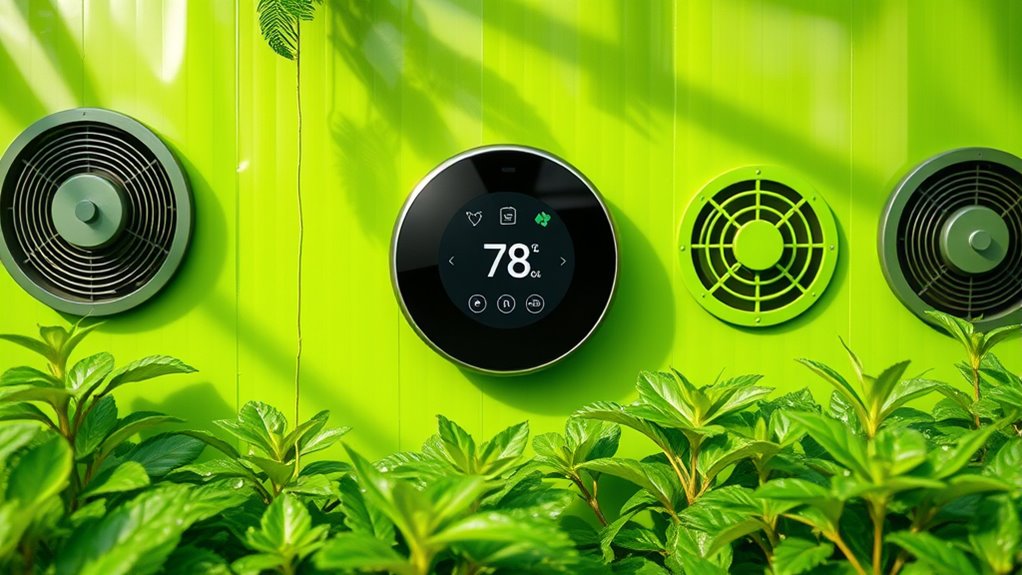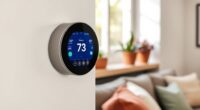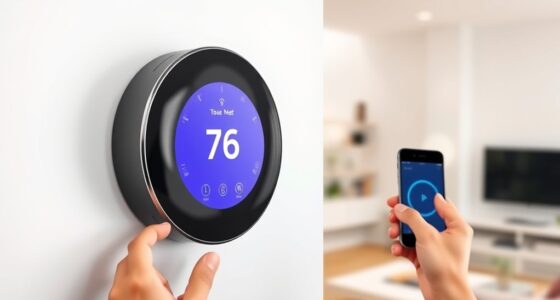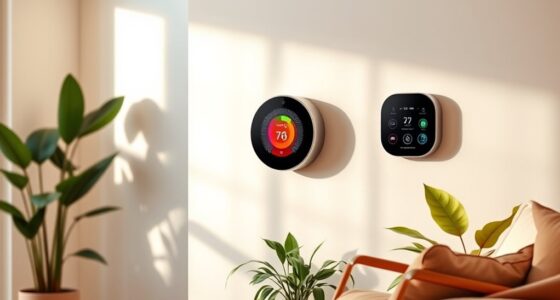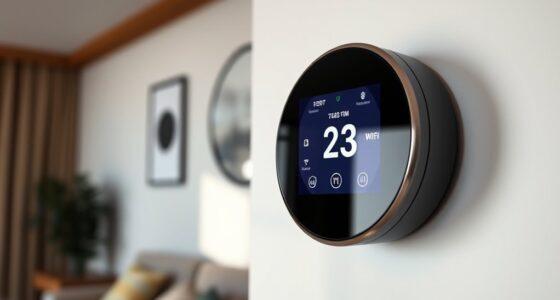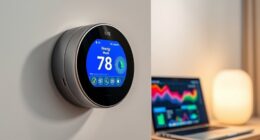If you’re looking to optimize your greenhouse conditions, using smart thermostats like the Meross Wi-Fi Outlet Plug, ecobee smart models, or wireless controllers with built-in sensors can make a big difference. From controlling fans and heaters to monitoring air quality, these devices help maintain ideal temperatures efficiently. I’ll guide you through the top options and what to contemplate so you can choose the perfect system for your setup. Keep going if you want to learn more!
Key Takeaways
- Choose thermostats with remote control and scheduling features for precise greenhouse fan automation.
- Opt for models with built-in sensors and environmental monitoring for accurate temperature and humidity regulation.
- Select Wi-Fi-enabled controllers compatible with smart home ecosystems like Alexa, Google, or Apple HomeKit.
- Consider high-capacity smart fans (e.g., AC Infinity T16) with automation support for large or demanding greenhouses.
- Prioritize easy installation, reliable connectivity, and compatibility with existing HVAC or ventilation systems.
meross Smart Wi-Fi Thermostat Outlet Plug for Heating and Cooling
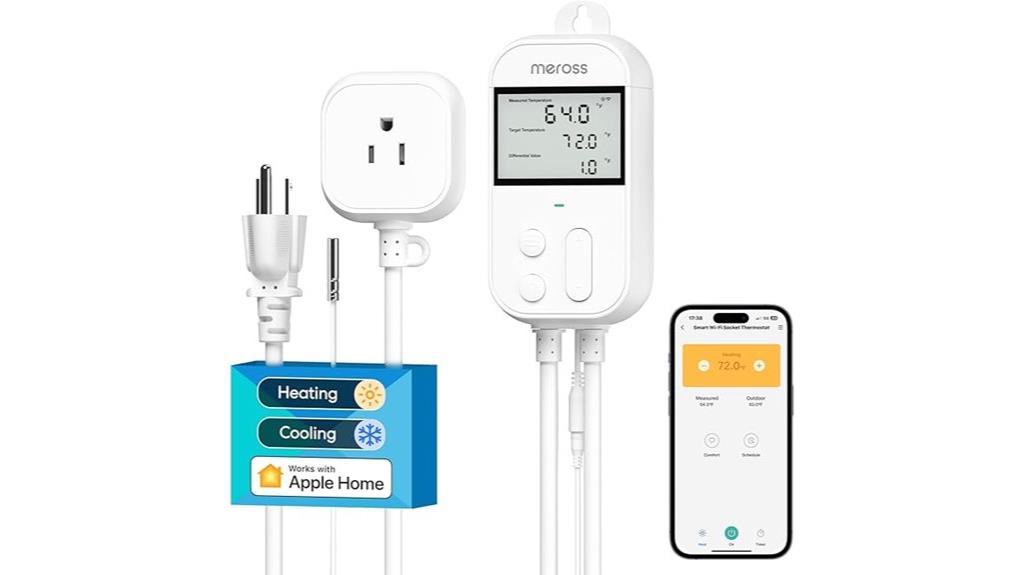
If you’re looking for an easy way to control your greenhouse fans and heaters remotely, the meross Smart Wi-Fi Thermostat Outlet Plug is an excellent choice. It offers simple operation through buttons, the free Meross app, or voice commands with Apple Home, Alexa, Google Home, and SmartThings. The LCD backlit display makes it easy to read in the dark. It supports heating and cooling devices like infrared heaters and refrigerators, with scheduling for up to 12 periods daily. Plus, it features energy monitoring and temperature history, giving you precise control and insights to maintain ideal growing conditions effortlessly.
Best For: DIY enthusiasts, gardeners, or homeowners seeking an easy, remote way to control heating and cooling devices for energy efficiency and convenience.
Pros:
- Easy operation via buttons, app, or voice commands with multiple smart home integrations
- Supports scheduling for up to 12 periods daily with energy monitoring features
- Reliable power-off memory ensures settings are retained during outages
Cons:
- Maximum load limited to 15A, which may not suit high-power devices
- Requires Wi-Fi connection for remote access and smart features
- Temperature sensor is designed for water placement, which might limit placement options for air-based environments
WTC100 Wireless Temperature Controller with Built-in Sensor
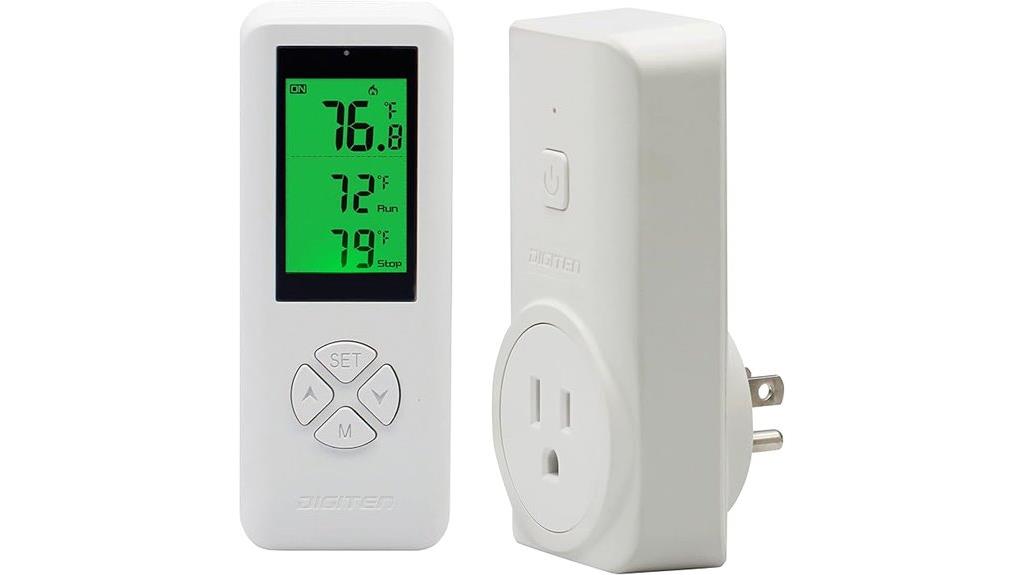
The WTC100 Wireless Temperature Controller with Built-in Sensor stands out for its ease of use and reliable remote monitoring, making it ideal for greenhouse growers who need precise temperature management without constant manual adjustments. It maintains stable environments by managing heating and cooling devices based on preset temperatures, with safety features like high/low alarms and a grounded socket. Its wireless remote control works up to 100 meters, allowing adjustments and monitoring from a distance. The LCD display is backlit for visibility, and the device retains settings during outages. Simple to set up—plug in, select mode, and auto-match—it’s a versatile tool for optimizing greenhouse conditions effortlessly.
Best For: greenhouse growers, home brewers, and environment enthusiasts seeking precise, remote temperature control with easy setup and reliable performance.
Pros:
- Wireless remote control covers up to 100 meters for convenient adjustments and monitoring
- Easy 2-step setup with plug-in and mode selection simplifies installation and operation
- Built-in sensor and backlit LCD display ensure accurate readings and visibility in various conditions
Cons:
- Limited to standard U.S. outlets, which may require adapters in other regions
- Relies on wireless connectivity, which could be affected by interference or obstacles
- May be less suitable for very large or industrial-scale applications requiring multiple controllers
ecobee Smart Thermostat Premium with Sensor and Air Quality Monitor
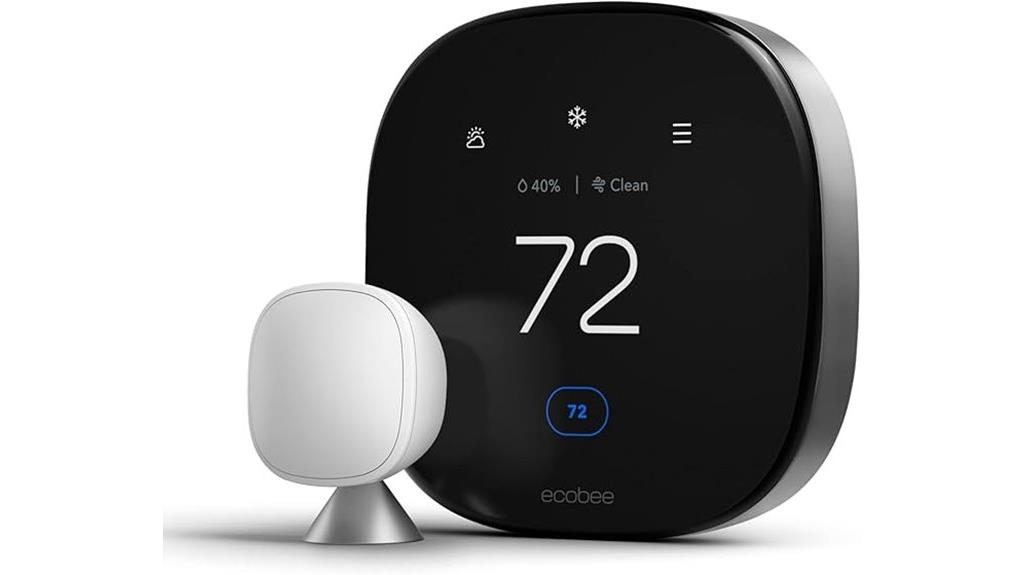
The ecobee Smart Thermostat Premium with Sensor and Air Quality Monitor stands out for greenhouse enthusiasts who want precise climate control combined with all-encompassing air quality monitoring. It can save up to 26% annually on heating and cooling costs and is ENERGY STAR certified. Its SmartSensor adjusts temperatures in key areas, reducing hot or cold spots, while the built-in air quality monitor alerts you to poor air conditions and reminds you to change filters. The thermostat also detects sudden temperature drops, providing notifications to prevent damage. Its sleek design, advanced interface, and voice control options via Siri or Alexa make it a versatile choice for optimizing your greenhouse environment.
Best For: greenhouse enthusiasts seeking precise climate control combined with comprehensive air quality monitoring to optimize plant health and environment.
Pros:
- Saves up to 26% annually on heating and cooling costs, enhancing energy efficiency.
- Built-in air quality monitor provides real-time alerts and maintenance reminders for optimal indoor air conditions.
- Sleek design with advanced interface and voice control options via Siri and Alexa for convenient operation.
Cons:
- Requires a compatible 24VAC HVAC system for full functionality.
- Security features need an additional ecobee Smart Security plan, increasing overall cost.
- Apple Home Hub is necessary for Siri integration, which may be an extra setup step for some users.
ecobee Smart Thermostat Essential – Wi-Fi Programmable Thermostat

Energy savings stand out as a major advantage of the ecobee Smart Thermostat Essential, making it an excellent choice for greenhouse enthusiasts seeking cost-effective climate control. It can cut energy bills by up to 23%, often paying for itself within six months. Its Wi-Fi connectivity and app controls make managing temperature easy, whether you’re home or away. Compatible with popular voice assistants and smart home systems, it’s simple to install and use. Designed for various HVAC systems, it works well with electric baseboard heaters, ACs, and furnaces. Overall, it’s a reliable, budget-friendly device that helps optimize your greenhouse environment while saving money.
Best For: greenhouse enthusiasts and homeowners seeking an energy-efficient, easy-to-install smart thermostat to control various HVAC systems and reduce utility bills.
Pros:
- Energy savings of up to 23%, with quick payback within six months
- Easy DIY installation with compatible smart home integration (Alexa, Google, Apple HomeKit)
- User-friendly app with scheduling, remote control, and compatibility for multiple devices
Cons:
- Limited scheduling flexibility, with only one season-based schedule allowed
- No advanced customization options for fan control and temperature holds
- Requires a C wire in some installations, which may need additional wiring or adapters
AC Infinity AIRLIFT T14 Shutter Exhaust Fan with WiFi Controller
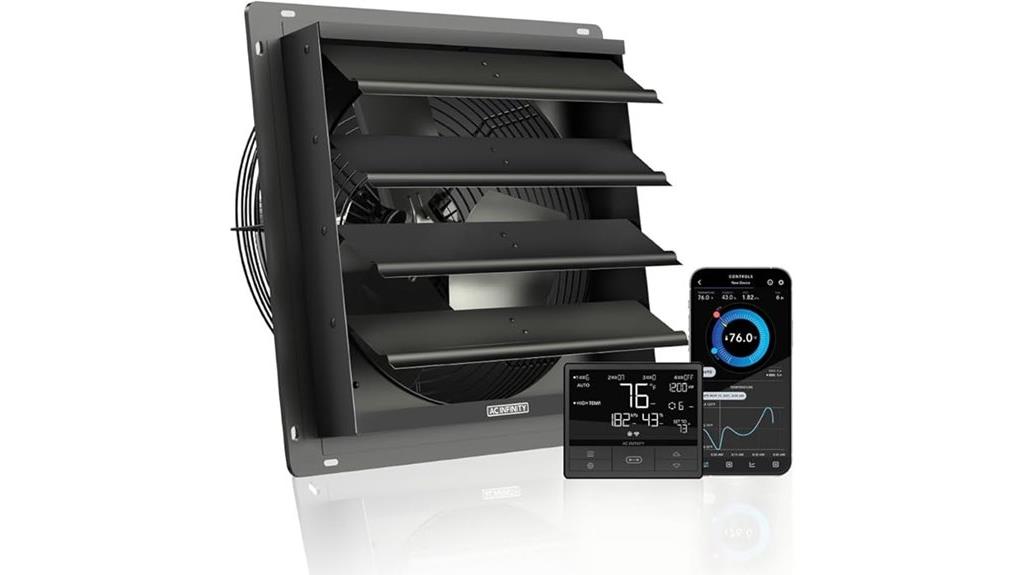
If you’re looking for a powerful, WiFi-enabled exhaust fan that can precisely regulate greenhouse environments, the AC Infinity AIRLIFT T14 stands out. This 14-inch fan delivers up to 1513 CFM, making it ideal for ventilation, cooling, and moisture control. It features steel shutters, aluminum blades, dual ball bearings, and an IP-44 rating for durability. The fan connects via WiFi, allowing you to control temperature and humidity remotely through an app. With programmable timers, multiple speed settings, and automation options based on climate data, it offers reliable, customizable environmental management, helping you maintain ideal conditions effortlessly.
Best For: indoor growers, greenhouse operators, and homeowners seeking precise, remote-controlled ventilation and climate regulation.
Pros:
- High airflow capacity of 1513 CFM for effective ventilation and moisture control
- WiFi-enabled app control with customizable programming, timers, and automation
- Durable construction with steel shutters, aluminum blades, and IP-44 rated for resistance to dust and liquids
Cons:
- Requires external thermostat or actuator for optimal louver control and automation
- Some users find installation may need custom mounting solutions depending on space
- Noise level of 68 dBA may be noticeable in quieter environments
AC Infinity AIRLIFT T16 Shutter Exhaust Fan with WiFi Controller
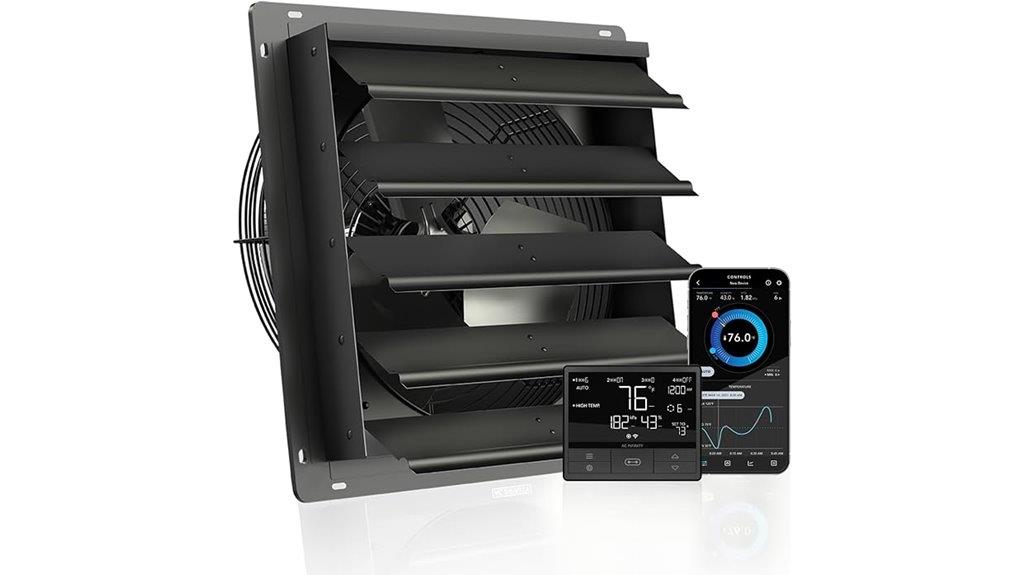
Anyone looking to automate greenhouse ventilation will find the AC Infinity AIRLIFT T16 Shutter Exhaust Fan with WiFi Controller to be an excellent choice, thanks to its advanced smart controls. This 16-inch, high-efficiency fan is built for robust ventilation and moisture control, featuring durable steel shutters, aluminum blades, and an IP-44 rating. It offers a powerful airflow of 2,560 CFM while operating quietly at 70 dBA. The WiFi-enabled control allows remote management via an app, enabling programmable temperature and humidity settings, timers, and alerts. Its flexible installation options and reliable performance make it ideal for maintaining *ideal* greenhouse conditions effortlessly.
Best For: Greenhouse owners, attic or shed ventilation, and indoor climate control enthusiasts seeking automated, remote airflow management.
Pros:
- WiFi-enabled smart controls for remote operation, scheduling, and alerts
- High airflow capacity of 2,560 CFM with durable steel shutters and aluminum blades
- Quiet operation considering its industrial design, with effective temperature and humidity regulation
Cons:
- Can be loud at higher speeds, similar to industrial exhaust fans
- Installation may require some handyman skills due to electrical and structural setup
- Occasional reports of motor twitching or stopping after extended use
BN-LINK Digital Thermostat Controller for Fans
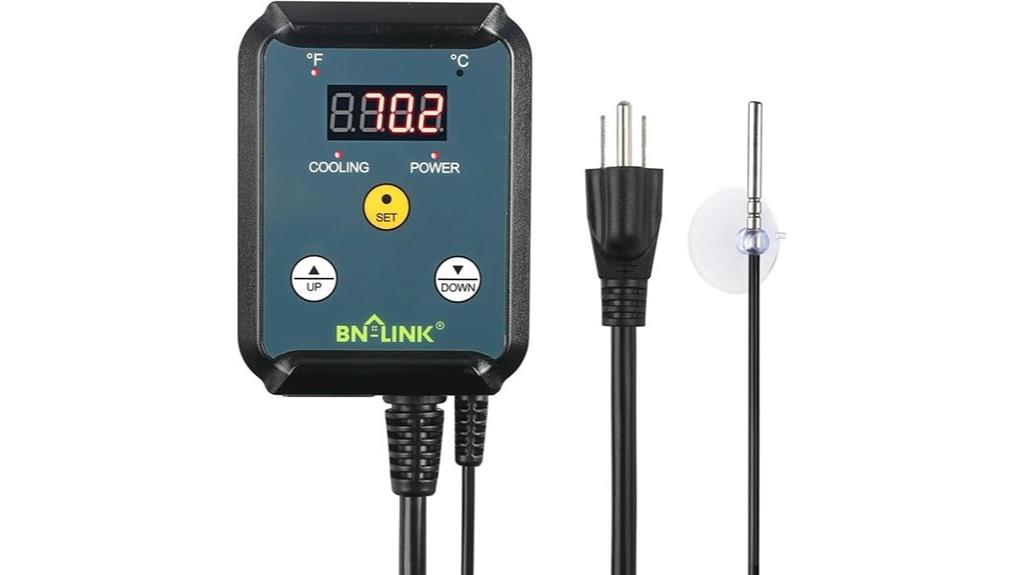
The BN-LINK Digital Thermostat Controller for Fans stands out for its precise temperature regulation, making it ideal for greenhouse enthusiasts who need reliable control over ventilation fans. It supports a temperature range of 40–108°F and features a clear digital display, easy-to-use buttons, and LED indicators for power and cooling status. The device includes a sensor probe and flexible mounting options, making installation straightforward. While it works well for controlling cooling devices like exhaust fans, users should be mindful of its load limitations—specifically, a maximum of 4A for inductive loads. Overall, it offers dependable, accurate temperature management for maintaining excellent greenhouse conditions.
Best For: greenhouse growers and enthusiasts seeking reliable, precise temperature control for ventilation fans within a safe load capacity.
Pros:
- Accurate temperature regulation with a clear digital display.
- Easy to install and operate with simple button controls and mounting options.
- Supports flexible placement thanks to included sensor probe and power cord.
Cons:
- Limited to a maximum of 4A for inductive loads like fans, restricting use with high-power devices.
- Some users report early device failures or malfunctions over time.
- Not designed as a surge protector, so thunderstorms may cause fuse blowouts or damage.
Grow Tent Fan with Auto Humidity Control
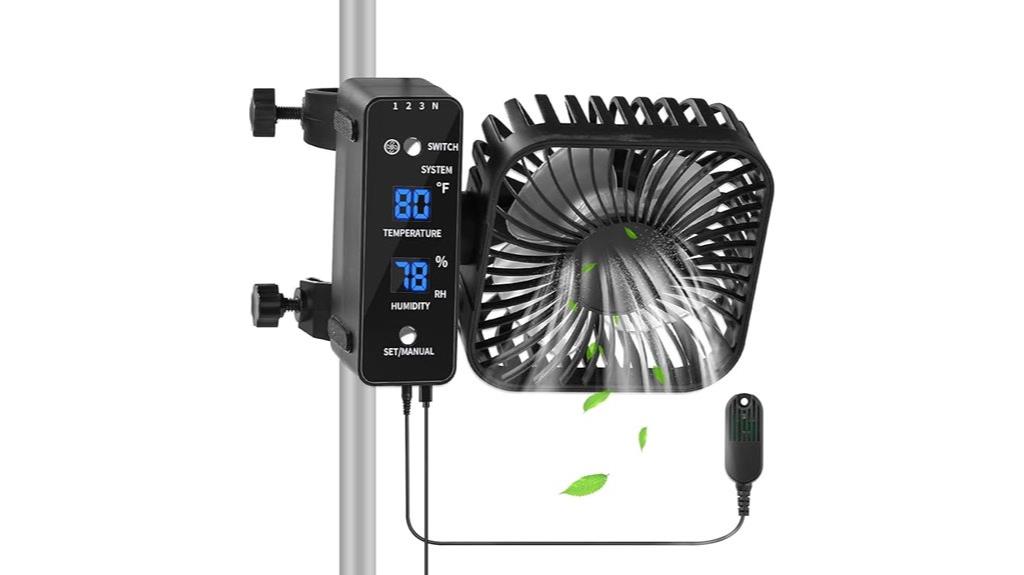
The Grow Tent Fan with Auto Humidity Control stands out for its automatic environment regulation, making it ideal for indoor gardeners seeking consistent climate conditions. It features real-time temperature and humidity monitoring, activating automatically when humidity exceeds your set limits. The fan offers four adjustable speeds and customizable airflow, ensuring ideal conditions for most plants. Its quiet operation, at just 25 dB, makes it perfect for noise-sensitive spaces. Compact and lightweight, it’s easy to install with adjustable brackets. Although some users report setup challenges and cable issues, overall, it provides reliable, automated humidity control, helping you maintain a healthy, stable environment for your plants.
Best For: indoor gardeners and plant enthusiasts seeking automated, quiet ventilation and humidity control to maintain optimal plant growth conditions.
Pros:
- Quiet operation at just 25 dB, suitable for noise-sensitive environments
- Automatic humidity and temperature regulation for consistent climate control
- Compact, lightweight design with adjustable brackets for versatile installation
Cons:
- Short power cable requiring an extension for convenient placement
- Lack of oscillation on/off switch, resulting in permanent oscillating airflow
- Occasional hardware issues such as buzzing sounds, overheating, or cable durability concerns
Saillong 2-Pack Attic Fan Thermostat Control with Adjustable Temperature Dial
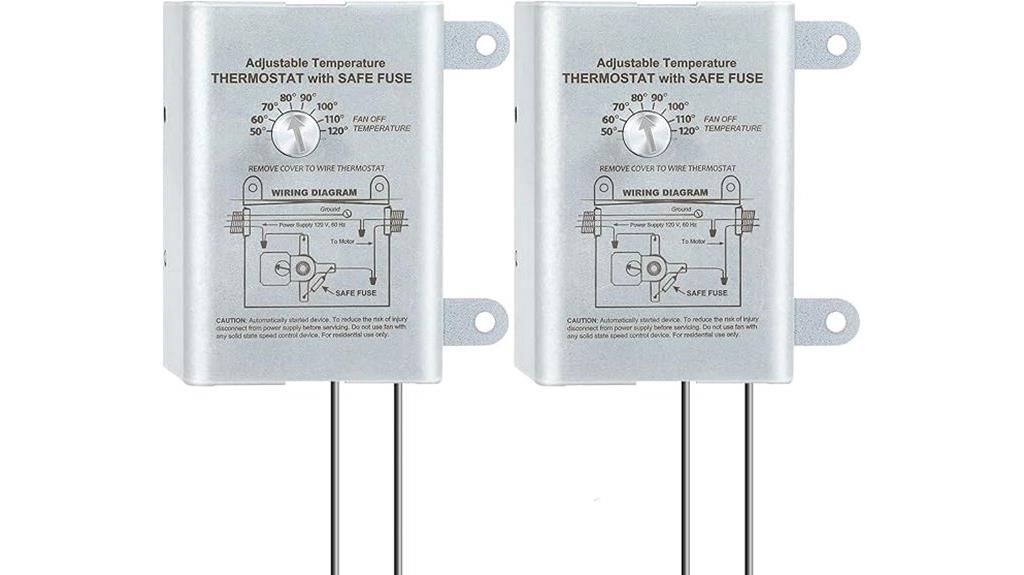
The Saillong 2-Pack Attic Fan Thermostat Control stands out for its adjustable temperature dial, making it a practical choice for greenhouses and ventilation systems. With a temperature range of 50°F to 120°F, it can automatically turn fans on or off to maintain ideal conditions. It supports up to three appliances at 10 amps, which is handy for managing multiple fans or ventilators. The device features a backlit LCD display, easy wiring, and manual control, allowing quick adjustments. Its modern design and simple installation make it a reliable, budget-friendly solution for regulating temperature in your greenhouse or attic space.
Best For: DIY enthusiasts and homeowners seeking an affordable, easy-to-install thermostat for attic, greenhouse, or ventilation fan control.
Pros:
- Adjustable temperature dial allows for quick and precise temperature settings without tools
- Supports multiple appliances (up to 3) at 10 amps, ideal for managing several fans or ventilators simultaneously
- Simple wiring and modern design make installation straightforward and user-friendly
Cons:
- May have an error margin of 5-10°F, affecting precise temperature control
- Reports of units arriving dead on arrival or with wiring difficulties can impact reliability
- Build quality concerns for handling higher power loads or long-term use
TURBRO Smart Temperature Controller Heating Cooling (TC01)
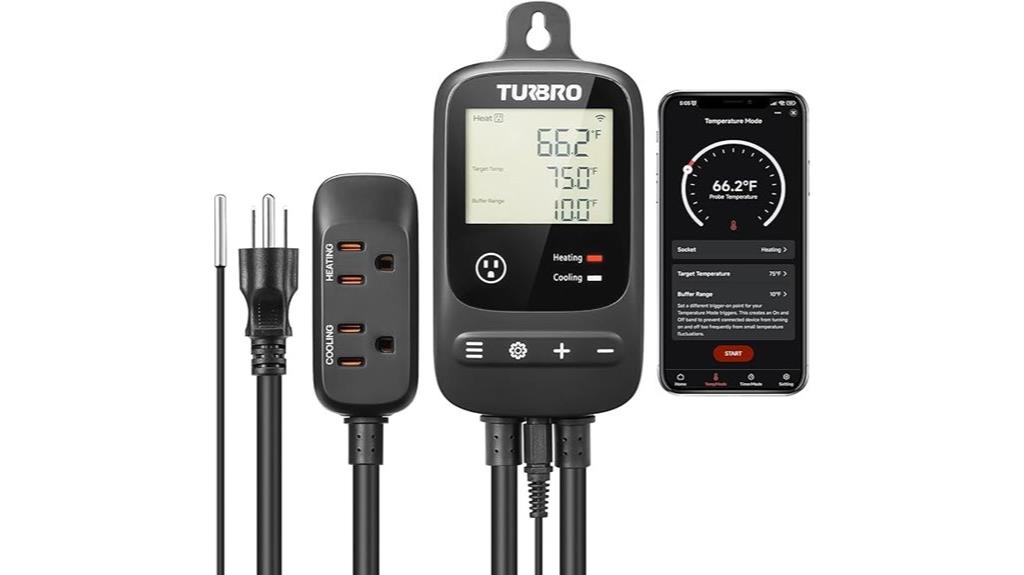
If you’re seeking precise temperature management for your greenhouse, the TURBRO Smart Temperature Controller Heating Cooling (TC01) stands out with its automatic device control within a wide range of 14°F to 212°F. It intelligently manages heating or cooling devices, with adjustable buffers to prevent rapid cycling and extend equipment life. The controller supports both Fahrenheit and Celsius, with calibration for accuracy. WiFi connectivity via 2.4GHz lets you remotely monitor real-time data and set schedules through the AIR.ai app. Its waterproof probe, safety alarms, and child lock make it durable and safe. Easy to install, it’s ideal for maintaining high-quality conditions in greenhouses, storage, or incubation environments.
Best For: hobbyists, farmers, or professionals seeking precise, remote temperature control for greenhouses, incubation, or storage environments.
Pros:
- Supports wide temperature range (14°F to 212°F) for versatile applications.
- WiFi connectivity allows remote monitoring and scheduling via the AIR.ai app.
- Waterproof probe and safety features enhance durability and security in various environments.
Cons:
- Requires a 2.4GHz WiFi network, which may be incompatible with some routers.
- Setup and configuration may be complex for users unfamiliar with smart devices.
- Power capacity limits (up to 15A/1800W at 120V) may not suit high-wattage equipment.
VEVOR Solar Attic Fan, 42W, 2800 CFM Roof Vent Fan
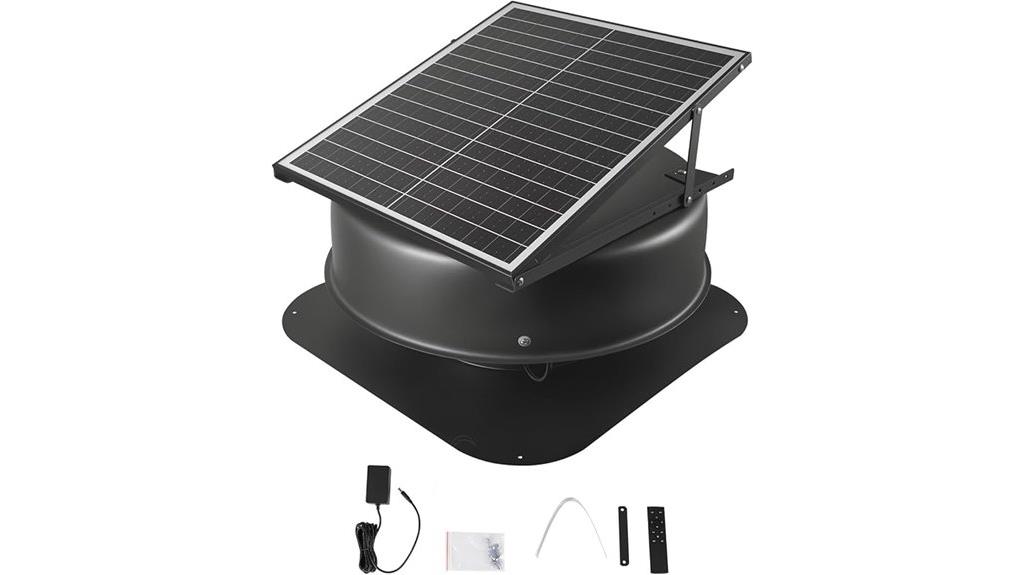
For greenhouse owners seeking reliable outdoor ventilation, the VEVOR Solar Attic Fan stands out with its powerful 2800 CFM airflow and solar-powered operation. It’s weatherproof, low noise, and easy to install on metal or masonry roofs, making it ideal for greenhouses, garages, or sheds. The fan features a 42W MPPT solar regulator that maximizes sunlight, activating automatically when temperatures exceed 26°C. It can operate 24/7, switching to electric power after sunset. With a remote control and adjustable solar panel angles, it offers flexible operation and efficient cooling, helping maintain ideal growing conditions while reducing energy costs.
Best For: greenhouse owners and outdoor enthusiasts seeking a reliable, weatherproof solar attic fan to improve ventilation and reduce energy costs.
Pros:
- Powerful airflow of 2800 CFM effectively ventilates large spaces like greenhouses and attics
- Weatherproof and durable design withstands hail, rain, and harsh outdoor conditions
- Easy to install with included flashing, remote control, and adjustable solar panel angles
Cons:
- Some users report airflow may fall below expectations or fan failure after a year
- Limited remote control range and lack of built-in batteries for continuous operation during shadows
- Concerns about durability and customer support, with some experiencing product issues and no warranty
Saillong Attic Fan Thermostat Control, Replacement Thermostat with Adjustable Temperature Dial
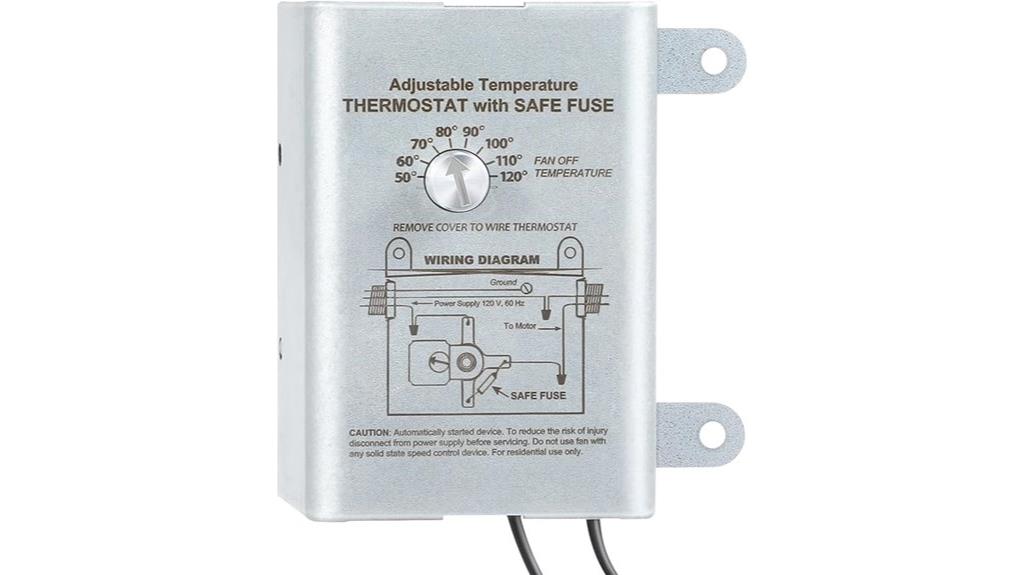
Saillong Attic Fan Thermostat Control stands out with its adjustable temperature dial, making it an ideal choice for greenhouse owners who want precise control over their ventilation systems. With a temperature range of 50℉ to 120℉, I can easily set the ideal conditions for my greenhouse. The clear finger dial switch allows quick adjustments without tools, and I can control up to three appliances simultaneously within a 10-amp limit. Installation is straightforward thanks to the included wiring diagram, and I appreciate its versatility for various cooling and exhaust systems. Keep in mind, environmental fluctuations might cause slight measurement errors, so I always monitor my setup regularly.
Best For: greenhouse owners and home enthusiasts seeking precise, adjustable control over their ventilation and cooling systems with easy installation.
Pros:
- Adjustable temperature range from 50℉ to 120℉ for customizable climate control
- Simple, tool-free adjustment with a clear finger dial switch
- Capable of controlling up to three appliances simultaneously within a 10-amp limit
Cons:
- Ambient temperature fluctuations may cause measurement errors of 5-10°F
- Limited to a 10-amp current, which may restrict higher-power applications
- Installation and setup may require attention to wiring details despite included diagram
DIGITEN Wireless Thermostat Outlet with Remote Control
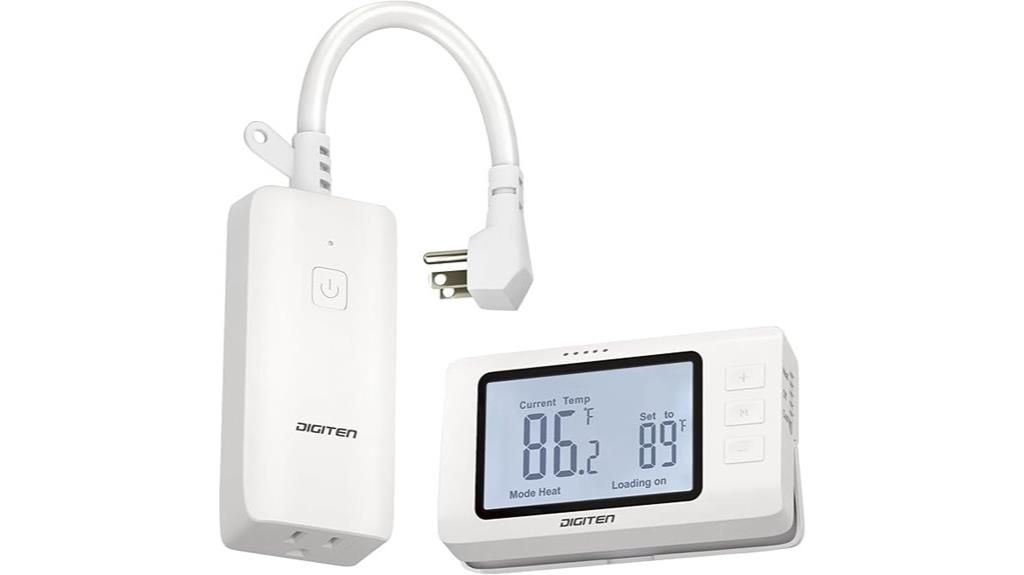
The DIGITEN Wireless Thermostat Outlet with Remote Control stands out as an ideal choice for greenhouse growers seeking precise temperature management. It controls appliances up to 1800W, making it perfect for fans, heaters, and air conditioners. Its user-friendly design lets me easily switch between heating and cooling modes, set temperatures, and choose Celsius or Fahrenheit. The large backlit LCD and remote control provide convenience, especially in low-light conditions. Its high-precision sensor ensures accurate temperature regulation, and safety features like separate sockets reduce overheating risks. Compact and reliable, it simplifies managing my greenhouse environment, keeping conditions perfect for healthy plant growth.
Best For: greenhouse growers and indoor enthusiasts seeking reliable, precise temperature control for their heating and cooling appliances.
Pros:
- User-friendly plug-and-play design with manual operation and remote control for convenience
- High-precision temperature sensor ensures accurate regulation within 1°C (2°F)
- Safety features like separate input/output sockets reduce overheating risks and enhance durability
Cons:
- Remote control requires 2 AAA batteries, which are not included
- Some functions may need referencing the manual for operation, such as button combinations and long presses
- Maximum load of 1800W may limit use with higher wattage appliances
Factors to Consider When Choosing a Smart Thermostat for Greenhouse Fans
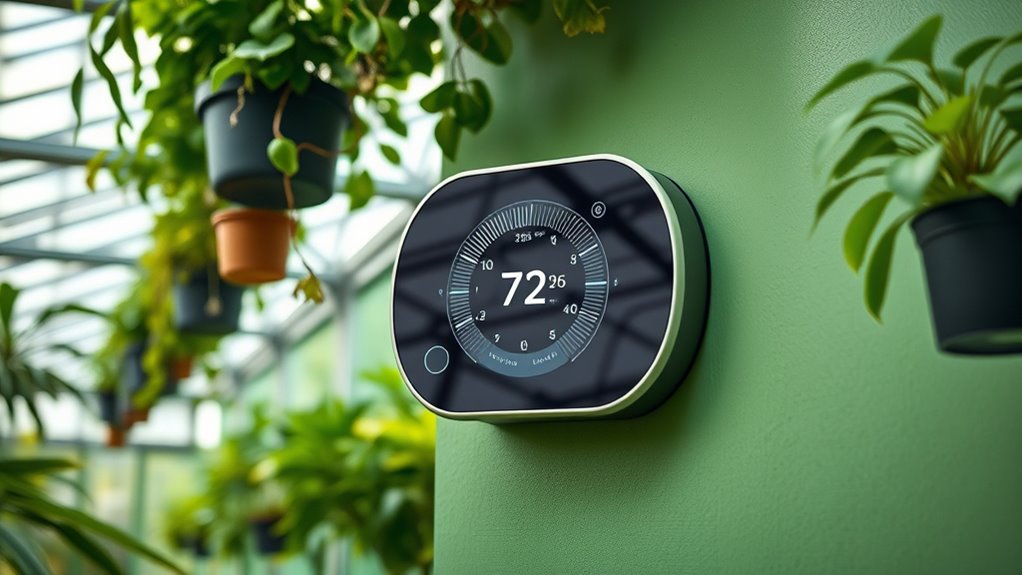
When selecting a smart thermostat for greenhouse fans, I consider factors like compatibility with different fan types and the temperature control range to guarantee precise climate management. Connectivity options and app usability are also key for remote monitoring and adjustments, while power source flexibility can impact installation ease. Finally, I look for models that are simple to install and operate to streamline setup and daily use.
Compatibility With Fan Types
Choosing a smart thermostat for your greenhouse fans requires ensuring it can handle the specific electrical and control requirements of your equipment. First, confirm it supports your fan’s electrical load and connector type, whether AC, DC, or variable speed. Compatibility with control protocols like WiFi, RF, or wired connections is essential to match your existing setup. Check if the thermostat can manage your fan’s power ratings—such as 120V or 240V—and maximum amperage, like 15A or higher. For fans with variable speed or digital control needs, verify the thermostat can handle precise regulation. Additionally, consider whether it offers manual override options for immediate control outside automated schedules. Ensuring these compatibilities will help you optimize your greenhouse environment effectively.
Temperature Control Range
Ensuring your smart thermostat covers the right temperature control range is vital for maintaining ideal greenhouse conditions. Most plants thrive between 50°F and 85°F, so your thermostat should support this spectrum. I recommend choosing a device with precise regulation, ideally with a differential of just 1-2°F, to avoid unnecessary fan cycling. It’s also important to verify if the thermostat has high or low temperature alarms to alert you when conditions go outside safe limits. Compatibility with your existing sensors or built-in sensors is essential for accurate readings. Additionally, check if the temperature range can be manually calibrated or adjusted, allowing you to fine-tune the climate for specific plants or crops. Proper range selection guarantees optimal growth and prevents temperature-related stress or damage.
Connectivity and App Use
The connectivity features and app capabilities of a smart thermostat substantially impact how effectively you can manage your greenhouse environment. I recommend choosing a model that supports WiFi or other reliable wireless protocols like RF for seamless remote access. Make sure the app is compatible with your smartphone’s OS—whether iOS or Android—and offers intuitive scheduling and monitoring tools. Look for real-time data, historical temperature logs, and customizable alerts to stay informed about your greenhouse conditions. The ability to control and program the thermostat remotely through a dedicated app is essential, so you can adjust settings from anywhere with internet access. Additionally, integration with popular smart home systems like Alexa, Google Assistant, or Apple HomeKit can streamline automation and enhance your greenhouse management.
Power Source Flexibility
Since power reliability can be a concern in greenhouse settings, selecting a smart thermostat with flexible power options is essential. I look for models that support multiple power sources like battery backup, AC power, or solar integration, ensuring continuous operation during outages or off-grid situations. Built-in rechargeable or replaceable batteries are also a plus, allowing the thermostat to function if the main power is interrupted. I prioritize thermostats with flexible wiring options, including compatibility with standard outlets, hardwired connections, or plug-and-play designs for convenience. Low voltage operation is important too, as it reduces electrical hazards common in greenhouses. Additionally, power management features like power-off memory or energy-efficient modes help prevent data loss and optimize energy consumption during fluctuations.
Installation Simplicity
Choosing a smart thermostat for greenhouse fans should focus on installation simplicity to save time and reduce frustration. I recommend selecting models with clear wiring diagrams and step-by-step instructions, making setup straightforward. Look for thermostats that support plug-and-play operation or require minimal wiring—these options cut down on complexity. Wireless remote setup or app-based configuration can eliminate the need for manual wiring altogether, streamlining the process. Devices with universal compatibility and simple mounting options like wall brackets or clamp fittings also make installation easier. Additionally, thermostats with indicator lights or display prompts can guide you through the process, reducing the need for technical expertise. Prioritizing these features ensures a hassle-free installation, so you can start optimizing your greenhouse conditions quickly.
Environmental Monitoring Features
Environmental monitoring features are essential because they provide real-time data on temperature, humidity, and sometimes VPD, allowing you to maintain ideal growing conditions. Built-in sensors help track these factors accurately, enabling precise climate control. Advanced sensors not only optimize plant growth but also prevent heat stress and reduce energy waste by adjusting ventilation automatically. Some thermostats include air quality monitoring, detecting pollutants, CO2 levels, or poor ventilation, which helps ensure a healthier environment for your plants and equipment. The ability to receive alerts or notifications based on environmental parameters allows me to proactively manage conditions before problems worsen. Overall, accurate environmental monitoring is critical for maintaining stable conditions, directly impacting plant health, yield, and the efficiency of my greenhouse operation.
Safety and Durability
Safety and durability are crucial factors when selecting a smart thermostat for greenhouse fans, especially given the humid and sometimes harsh outdoor conditions. Look for models with built-in safety features like overload protection and proper grounding to prevent electrical hazards. Choose thermostats housed in weather-resistant, sealed casings that can withstand moisture, dust, and temperature changes. Accurate, reliable temperature sensors ensure consistent performance despite environmental stresses. High-quality construction, such as stainless steel sensors and impact-resistant materials, helps prolong the device’s lifespan. Additionally, opt for thermostats with power-off memory and fail-safe modes. These features keep your system safe and operational during power outages or surges, providing peace of mind and reliable control for your greenhouse environment.
Frequently Asked Questions
How Do Smart Thermostats Improve Greenhouse Climate Control?
Smart thermostats improve greenhouse climate control by allowing me to precisely monitor and adjust temperature settings remotely. They learn my preferences over time, providing automated adjustments that maintain ideal conditions for my plants. With real-time data and alerts, I can respond quickly to any changes, ensuring supreme growth environments. This technology saves energy, reduces manual work, and helps me keep my greenhouse consistently healthy and productive.
Can Smart Thermostats Be Integrated With Existing Greenhouse Sensors?
They say, “The whole is greater than the sum of its parts,” and that’s true with smart thermostats and greenhouse sensors. Yes, I’ve found that many smart thermostats can seamlessly integrate with existing sensors, creating a unified climate control system. This integration allows for precise adjustments, ensuring ideal growing conditions. Just make sure your sensors are compatible—most modern thermostats support common communication protocols like Zigbee or Z-Wave.
What Security Features Do Smart Thermostats Offer for Remote Access?
When I look at the security features of smart thermostats for remote access, I see they offer robust protections. They typically include encrypted connections like WPA3, two-factor authentication, and regular firmware updates to patch vulnerabilities. These features help keep my data safe and prevent unauthorized access. I always recommend enabling all security options and keeping the device updated to guarantee your smart thermostat remains secure while managing your greenhouse remotely.
Are Smart Thermostats Energy-Efficient for Greenhouse Fan Management?
When it comes to energy efficiency, smart thermostats really shine—think of them as your greenhouse’s best guardian. I’ve found they actively learn your fan usage patterns, reducing unnecessary energy waste. This means lower bills and a greener footprint. They adapt to your needs, ensuring your plants get just the right climate without overdoing it. Honestly, they’re a smart investment in both your garden’s health and your wallet.
How Do Smart Thermostats Handle Power Outages or Connectivity Issues?
When power outages or connectivity issues happen, I find that smart thermostats often have backup features like battery power or local controls to keep things running smoothly. Some can store settings locally, so they continue operating even without internet. I make sure to choose models with these features because it gives me peace of mind that my greenhouse stays at the right temperature, no matter what happens with the power or connection.
Conclusion
Choosing the right smart thermostat can really turn things around for your greenhouse. With so many options out there, it’s about finding the perfect fit for your needs and climate. Remember, a smart thermostat is only as good as the attention you give it—don’t let good technology go to waste. When you pick wisely, you’ll be able to keep your plants happy and thriving, proving that every cloud has a silver lining.
